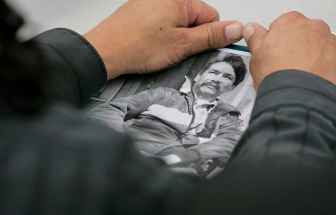Blue-bin blues Many Winnipeggers are either mistaken, lazy or don't care about discarding their recyclables correctly
Read this article for free:
or
Already have an account? Log in here »
To continue reading, please subscribe:
Monthly Digital Subscription
$0 for the first 4 weeks*
- Enjoy unlimited reading on winnipegfreepress.com
- Read the E-Edition, our digital replica newspaper
- Access News Break, our award-winning app
- Play interactive puzzles
*No charge for 4 weeks then price increases to the regular rate of $19.00 plus GST every four weeks. Offer available to new and qualified returning subscribers only. Cancel any time.
Monthly Digital Subscription
$4.75/week*
- Enjoy unlimited reading on winnipegfreepress.com
- Read the E-Edition, our digital replica newspaper
- Access News Break, our award-winning app
- Play interactive puzzles
*Billed as $19 plus GST every four weeks. Cancel any time.
To continue reading, please subscribe:
Add Free Press access to your Brandon Sun subscription for only an additional
$1 for the first 4 weeks*
*Your next subscription payment will increase by $1.00 and you will be charged $16.99 plus GST for four weeks. After four weeks, your payment will increase to $23.99 plus GST every four weeks.
Read unlimited articles for free today:
or
Already have an account? Log in here »
Hey there, time traveller!
This article was published 21/09/2018 (2638 days ago), so information in it may no longer be current.
The sticker on the lid of the blue recycling cart is faded and peeling, but clear: “Paper, glass and plastic containers.” The plastic bag with a line through it would seem to speak for itself.
Open the lid, however, and what will you see? Plastic bags. So many plastic bags. Some are loose. Some are filled with recycling. There are even plastic bags stuffed inside plastic bags.
And it’s not just bags. In recent weeks, the communal blue carts outside this Crescentwood condominium have contained a string of dubious objects. A fur vest. A wicker basket. A plastic patio chair. A pot without a handle. Flatware. A broken plate. A bundle of used Swiffer pads and dryer sheets. A panini press inside — wait for it! — a plastic bag.
According to the City of Winnipeg, the most recent statistics show 32.9 per cent of residential solid waste was diverted away from landfills in 2016, but a recycling-material audit shows the level of contamination in the city’s recycling programs from July 2016 to June 2017 was more than 13 per cent.
Is it ignorance? Laziness? Or wilful disregard for the rules?

The City of Winnipeg recently launched an ad campaign, featuring tips about what to keep out of recycling carts and a clippable poster that outlines what items are allowed.
An unscientific study of the kinds of items that regularly turn up in blue bins and carts points to three categories of recycler.
The first is the well-meaning but misguided recycler. These are the people discarding items that, at first glance, appear to be recyclable, but which the City of Winnipeg cannot accept for various reasons.
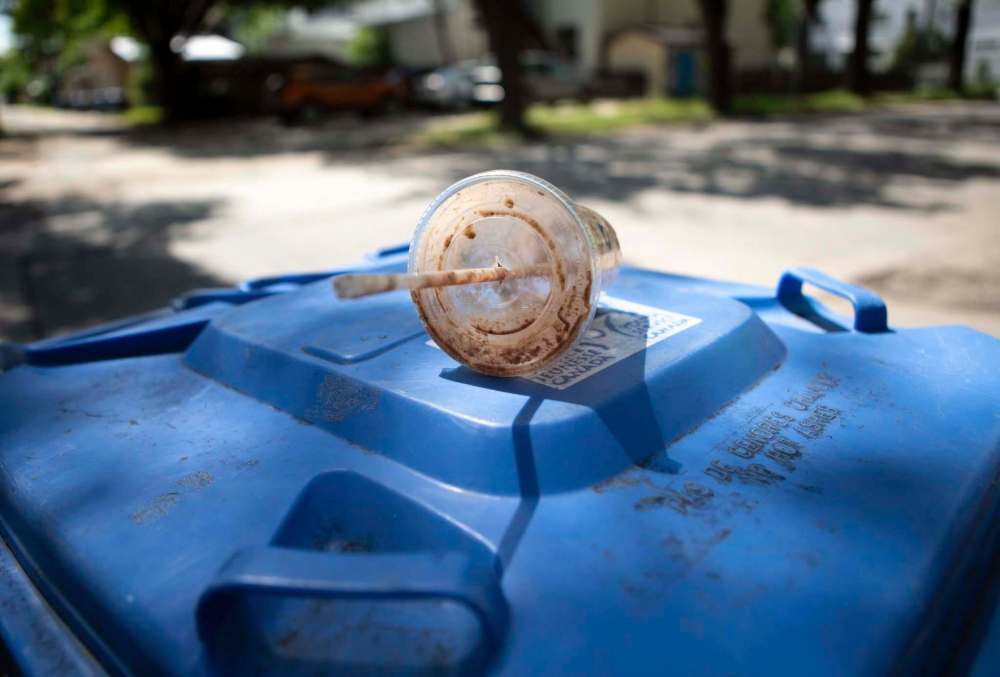
This list includes things like black plastic (for example, the containers mushrooms are packaged in at the supermarket or coffee-cup lids), plastic wrap (either cellophane or the thicker type), Styrofoam (such as takeout containers, coffee cups or meat trays), paper cups (the kind you get at Tim Hortons or Starbucks, even the compostable ones), foil containers (such as takeout trays or pie plates) and glossy coloured paper (gift bags, wrapping paper).
Many of these items are marked with the triangle symbol that seems as if it should be the universal indicator of “recyclable,”; however, that mobius logo is not the all-clear to throw things in the blue bin.

A subset of the well-meaning are the nesters. These are folks who endeavour to save space by placing smaller items in larger ones — pop cans in soup cans, shampoo bottles crammed into empty cereal boxes. Because 90 per cent of recycling is not sorted manually at the depot, this stuff often gets discarded. That’s right: your nested items are likely to be rendered landfill.
Others put their recyclables in a plastic bag before depositing them in the blue bin. This also becomes garbage: the automated system does not empty out the bags and no one working as a manual sorter should be expected to stick his or her hands into opaque bags. They are thrown out with their contents.
The second category is made up of people who are just winging it and hoping for the best — what those in the business call “wishful recyclers.” This includes people who have failed to make the distinction between “reusable” and “recyclable.” These are the folks who are putting in clothing, running shoes, pot and pans and electronics.
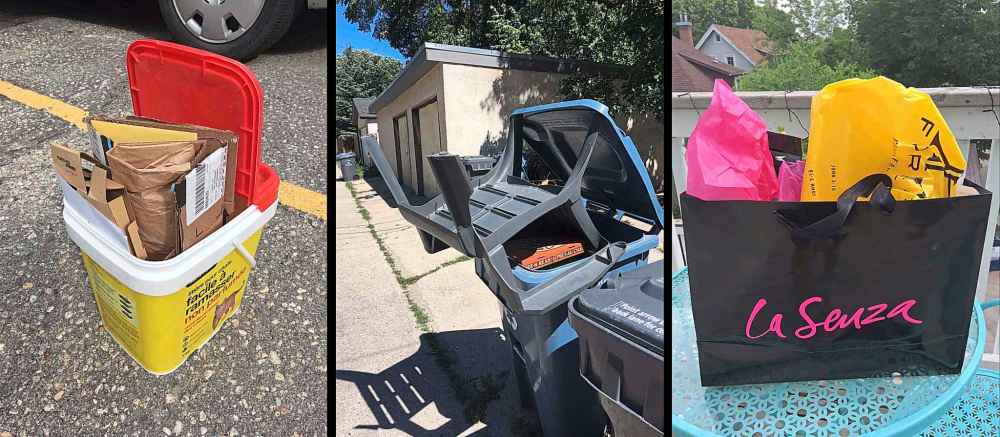
Finally, there are the folks who flip the bird to the very idea of recycling. They’re responsible for the unadulterated garbage that’s chucked in the blue bin, even when there’s a trash can right next to it. They’re behind that dirty diaper, the sprinkle of fast-food fries or the half-full Slurpee cup whose spilled contents render the entire contents of the bin unusable.
Whatever category you fall into, when you fail to recycle correctly, your actions cost money and contribute to landfill. But how bad are we, really?
A Free Press photographer and reporter, armed with the City of Winnipeg’s What Can I Recycle? list, headed out into the Wolseley area on recycling day to see how granola-belt denizens fare.
There’s an app for that
Want to know where to take old paint or batteries? Confused about the difference between container glass and glassware? Just interested in becoming a better recycler? Download the free RecycleCoach app, an informative resource that can be localized to provide recycling rules specific to your city.
Want to know where to take old paint or batteries? Confused about the difference between container glass and glassware? Just interested in becoming a better recycler? Download the free RecycleCoach app, an informative resource that can be localized to provide recycling rules specific to your city.
The app has an answer for almost any item you can think of (Keurig coffee pods? Garbage. Religious artifacts? Ask your spiritual adviser, but likely not recyclable no matter what your denomination), as well as explanations for why certain things are forbidden.
Greasy pizza boxes, for instance, are one of the worst offenders. Here’s why: when glass, plastic or metal are recycled, the process uses heat that can burn off food residue. Paper is not heated during the recycling process, and after being sorted into different grades and types, it may sit around for weeks in a paper mill, where the grease can turn rancid and attract bugs.
Later, paper products are washed in soapy water to remove inks, staples, plastic film and glue. Large batches are then mixed with water to make a slurry. Any grease or oil floats to the top and can’t be separated from the paper fibres; it may ruin the whole batch of paper products.
The city advises people to remove the lid of the box, if it’s unsoiled, for recycling, but to throw the rest in the garbage.
RecyleCoach also features a 100-point quiz to assess your recycling knowledge. A number of Free Press staffers took the test and the results were disheartening.
Even among the younger staff members — whom you might imagine would fare better, having grown up with recycling — the scores were fairly dismal, with most scores hovering in the 60s.
The City of Winnipeg is aware of the public confusion regarding what’s acceptable. It is running ongoing education campaigns to inform the public of what can and cannot be recycled in the residential program and at 4R Winnipeg Depots, as well as to correct long-standing misconceptions and provide updates.
These campaigns include a mix of traditional advertising (print, radio, billboards etc.) and new media (social media and online advertising).
Some basics
What goes in the bin? Paper, cardboard and plastic/metal/glass containers.
Anything that’s not accepted is garbage, which increases the cost of recycling, ruins other recyclables and can damage equipment. Manual sorting adds to the cost of recycling.
Plastic bags don’t go in the cart — bagged material ends up as garbage. Plastic bags can be returned to major grocery stores for recycling.
Mobius loop: the recycling triangle doesn’t mean an item is accepted. Common items with a triangle that aren’t accepted include: foam, film, foil, coffee cups, black plastics. Recyclers should focus on the city’s accepted list and not the triangle (and don’t worry about the number).
Clothing doesn’t go in the cart; it will end up in the garbage. Check with your local thrift shops — some accept even damaged or soiled textiles for recycling.
Don’t let your hard work go to waste: empty and clean containers; separate materials; don’t nest; when in doubt, find out.
Have you spotted some egregious recycling errors in your neighbourhood? Do you have questions about whether a particular item is recyclable, garbage or reusable? Send a picture to readerpix@freepress.mb.ca. We’ll run a collection and answer your questions in a future story.
Neither of them thought to bring gloves, but never fear — a pair of blue latex ones (note: not recyclable) turned up not long into the assignment.
The bins outside Tall Grass Prairie Bakery were picture-perfect examples of recycling done right: cardboard boxes flattened, not a speck of garbage. Even the bakery’s flour bags, normally not accepted because a waxy coating, were an untreated paper variety.
Moving on, however, the stereotype of Wolseley as the green zone was almost immediately proven false. The public bin in front of the bakery was filled with soiled paper plates, dirty plastic cups (recyclable, but not when covered with food), plus plastic straws and many of the bakery’s compostable coffee cups, which can’t be recycled.
And further on down the lane, it got worse. Blue bins and carts should be relatively clean and fly-free; their sides should not be splashed with sticky liquids or goo.
In reality, they were almost as filthy as garbage cans — and filled with almost as much trash, some of it hazardous waste.
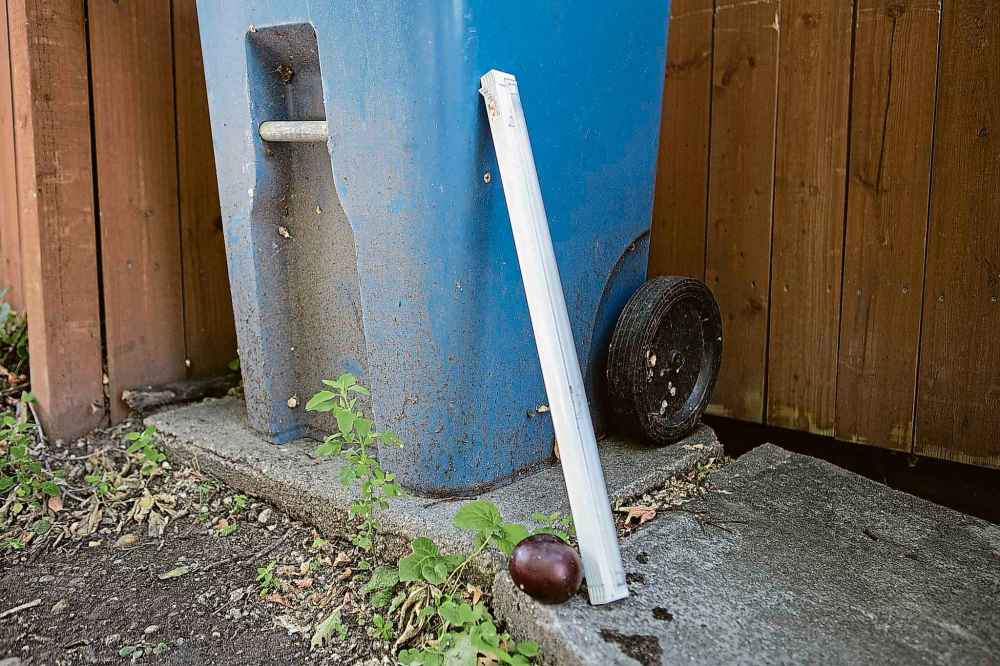
One recycling bin was overflowing with such varied forbidden items as rotting fruit, foil potato chip bags, used tissues, a scattering of Q-tips, and a fluorescent light bulb, which contains mercury and shouldn’t even be discarded in the garbage. After gamely arranging them into a trashy tableau called “Still Life with Plum” (and pocketing the bulb for deposit at a 4R Depot), it was on to the next bin.
It only took a couple of blocks to turn up examples of almost everything that cannot be recycled in Winnipeg: glassware (some broken); plastic toys; computer keyboards; electrical cords; paper towels, aluminum foil; packing peanuts; foil pie plates; greasy pizza boxes, clothing and textiles; and, of course, those ubiquitous plastic bags.
Meet Murf
Winnipeg’s material recovery facility or MRF, known familiarly as “Murf,” processes everything from the curbside collection program. It runs five days a week and processes an average of 90,000 kilograms of material a day.
It’s an automated single-stream system, meaning neither customers nor collectors have to pre-sort the material.
Winnipeg’s material recovery facility or MRF, known familiarly as “Murf,” processes everything from the curbside collection program. It runs five days a week and processes an average of 90,000 kilograms of material a day.
It’s an automated single-stream system, meaning neither customers nor collectors have to pre-sort the material.
Three star screens (a series of shafts fitted with rotating cams shaped like asterisks) separate the paper materials from the beverage containers. The paper products are propelled forward, while the containers fall through the openings between the shafts.
More than 90 per cent of the paper is removed mechanically. The remainder, along with any contaminants, is removed by manual sorters.

Mark Kinsley, supervisor of Winnipeg Waste Diversion
The individual materials are then baled and placed in the shipping area to await transportation to manufacturing plants all over the world.
Mark Kinsley, supervisor of Winnipeg Waste Diversion, explains that even with manual sorting, the MRF’s process works best if residents try to restrict their recycling to one material per item (ie: no metal lids on glass jars) because the materials go to different places.
It’s also why putting invalid material in your bin is a safety concern. Glassware breaks differently than container glass and tends to have more splinters and sharper edges, which can harm sorters. Textiles can catch in the machinery.
It’s also why you should replace the plastic lids on plastic bottles (after rinsing them); loose lids are too small for the MRF to process.
The optical sorting stage is the reason black plastics cannot currently be recycled — the belt that moves the material is also black, so the sorter can’t recognize the dark plastics against it.
— Source: winnipeg.ca/waterandwaste
Though some of the above items were discarded thoughtlessly, much of would-be recyclers’ confusion can be forgiven. The City of Winnipeg’s rules can seem arbitrary — why wouldn’t the thick plastic protecting an IKEA shelving unit go in the bin? It’s plastic, it’s got a triangle on it — and the exceptions aren’t necessarily logical.
Public receptacles all over town trumpet: “Put your beverage containers here!” There’s no asterisk to signal a disclaimer: *”Except paper coffee cups.” And once you’ve discarded the cup, how to know the disposable lid only works if it’s white plastic?
In the past, Winnipeggers were told not to bother rinsing out containers and that pizza boxes could go in the blue bin (it says so right on the cart lid, in fact). But those rules have changed, based on the needs and requirements of the companies the city has contracts with to take different classes of recycled goods.
“It can be very confusing,” admits Mark Kinsley, a Winnipeg Waste Diversion supervisor, as he walks through the city’s latest 4R Depot on Panet Road, one of three locations where Winnipeggers can drop off the many items not accepted for residential recycling.
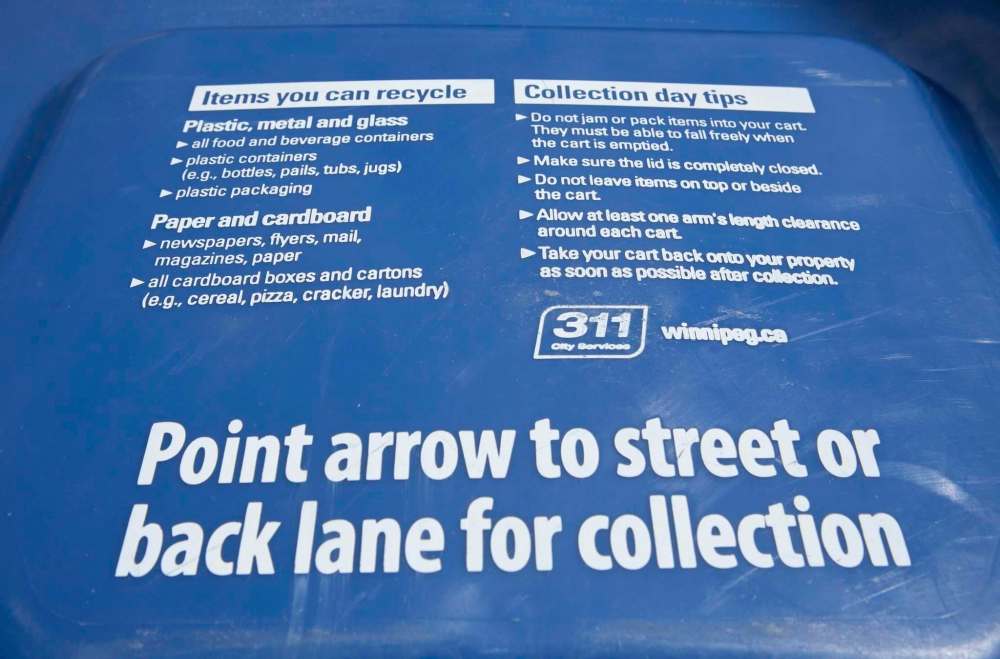
“We want everything to be as clean as possible,” he says, adding that means not just removing food residue, but also trying not to mix materials, keeping things homogenous. “Ideally, you’re taking your metal lids off your glass jars, which you’ve cleaned out. You can bring your windows here (to the 4R Depot), but they can’t have frames.”
Foil or plastic film on plastic yogurt and cheese containers, for instance, should be removed and discarded.
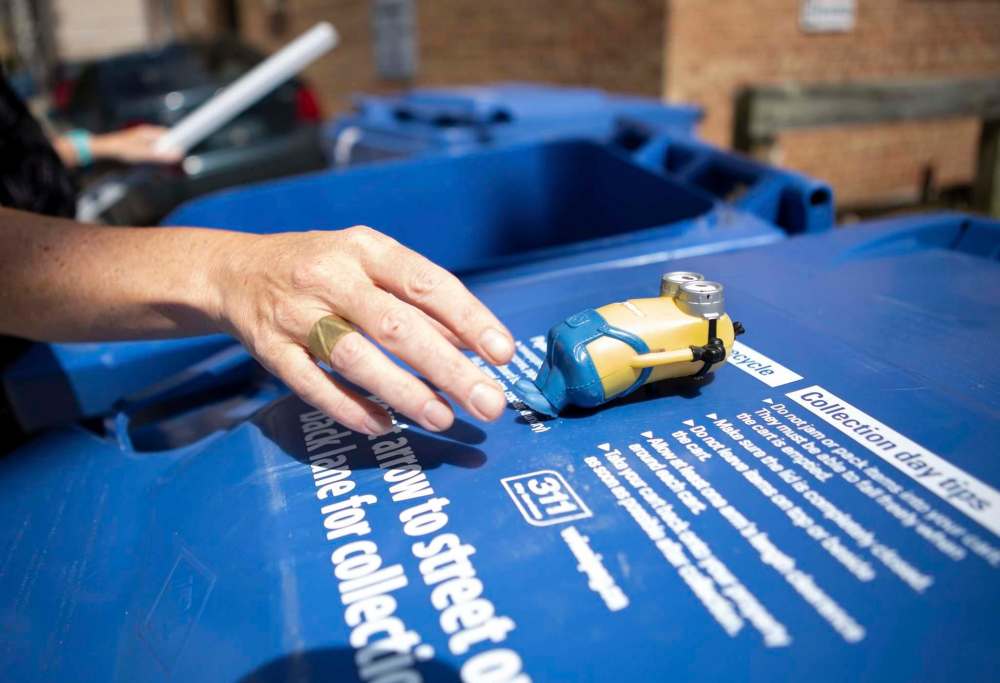
As for the mixed messages city residents may feel they’ve received over the years, Kinsley understands the frustration but points out that the city has no control over what’s accepted.
“One of the confusing, challenging things about about the recycling industry is that it’s always changing,” he explains. “It’s great to put it in your bin or bring to your 4R Depot to drop off, but it needs somewhere to go after. The circular effect changes (based on) the market, so before, the market wasn’t as concerned about residual food or liquid. Well, now they are.
“A big thing that’s been in the news lately is China was accepting lots of North America and the rest of the world’s material, and they’ve basically shut the doors. Long story short, it’s because they were getting too much literal garbage in recycling loads.”
Best rule to follow? If you don’t know, find out. Information is available from 311, on winnipeg.ca and through the RecycleCoach app.
“We’re trying to get the best message out that will get us the best material but also not confuse people to the point where they say, ‘What’s the point? I don’t know what to do anymore,’” Kinsley says. “It’s a unique challenge.”
jill.wilson@freepress.mb.ca
Twitter: @dedaumier
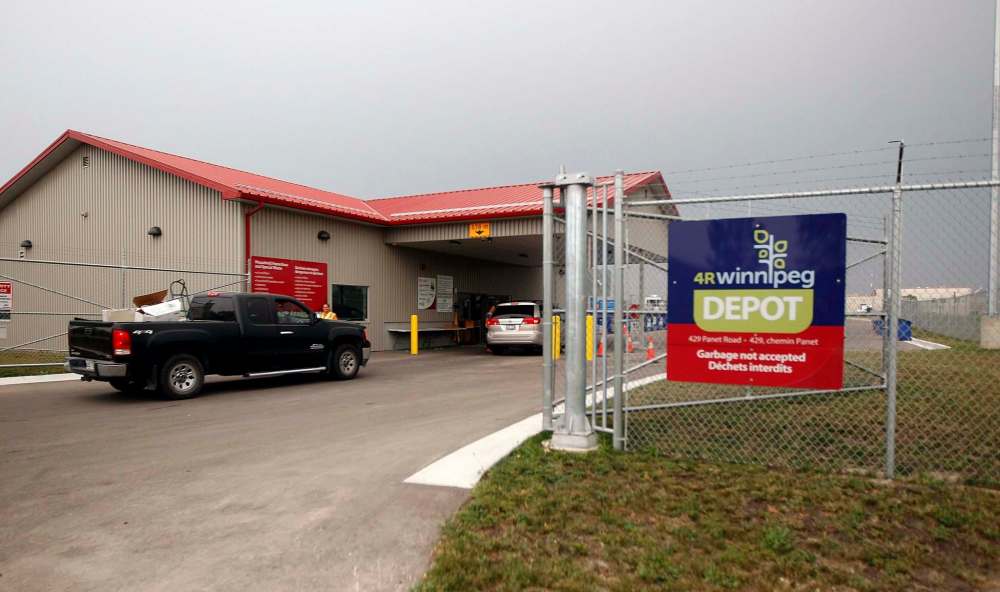



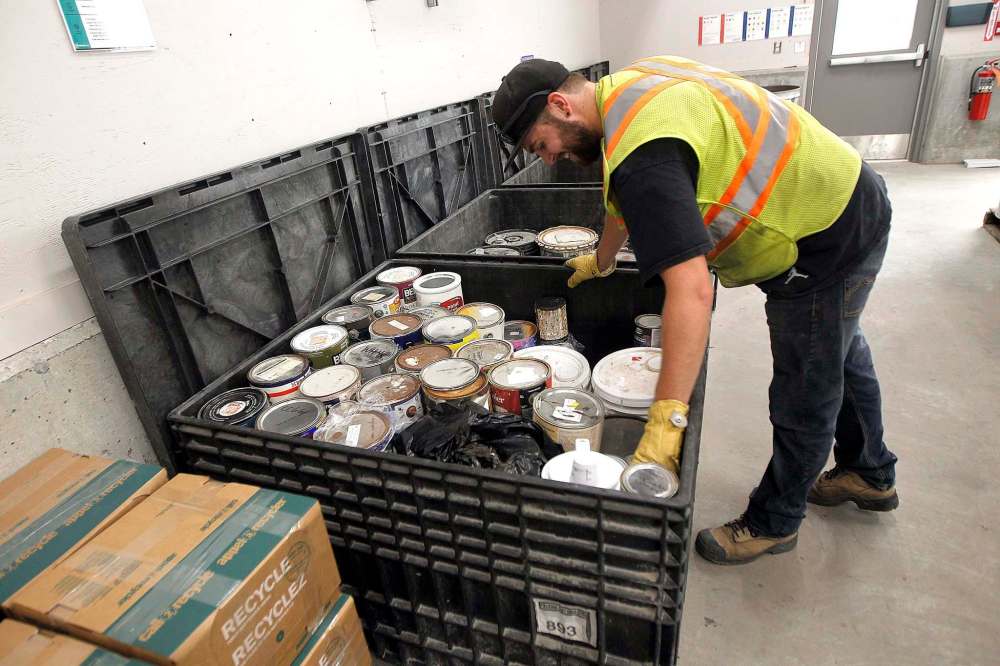
Take it to the depot
So what to do with all the items that don’t belong in the blue bin? Many of them are accepted at the city’s three 4R Depots, where Winnipeggers can drop off everything from paint and petroleum to pots, plants and patio furniture.
The newest of these is at 429 Panet Rd. (the others are 1120 Pacific Ave. and 1777 Brady Rd. — only Brady also accepts household waste). These depots process regular household recyclables — this is where you can take items too big for your cart — as well as a long list of other items and materials that are either reused, composted, recycled or repaired in partnership with different companies.
“It’s all based on a stewardship program; there’s different responsibility organizations” says Mark Kinsley of Winnipeg Waste Diversion. “So one… would deal with the HHW (hazardous household waste). Another deals with electronics — they’re packaged on specific pallets with a height restriction, then picked up and taken to a plant where the plastic is separated from the glass, precious metals. It’s the essence of waste diversion in that it’s trying separate as many of the parts as possible.”
“It’s similar to recycling: all the City of Winnipeg does is package it up at the plant — we just bale everything, we don’t manufacture. We send it on to the next stop where they’re going to deal with it, dispose of it properly or recycle it.”
One program sees glass ground up and used instead of gravel as a road base. In another — unique in Canada — bicycles are donated to the community bike program WRENCH (Winnipeg Repair and Education Cycling Hub), which either refurbishes them or uses the parts in programs to teach bike repair and make new bicycles.
Staff are on-site to handle the hazardous materials and point people to the right zone for drop-off of their other items.
“Most times people have the right mindset, but sometimes they can get confused and there are some misplacements so we do try have staff making their way around — we know we have to continually educate and support people in their diversion activities.”
Kinsley says it’s important to keep one thing in mind: “It’s not what’s technically recyclable. It’s what’s recyclable here.”
He points to paper cups as items for which recycling programs exist, but for which Winnipeg does not have a contract, because it’s very expensive.
The Panet 4R Depot opened earlier this year and traffic has steadily been increasing; a regular weekday will see about 200 cars drive through, dropping off paint and aerosol cans, yard waste, kettles and cardboard boxes.
Here’s what’s accepted at the depot:
Glass (in addition to what’s accepted residentially): Windows (without frames), glassware, broken glass (no windshields)
Leaf and yard waste: Grass clippings, leaves, plants, flowers, branches less than 10 centimetres in diameter
Clean fill: Soil, clay, sod, sand
Tree wood waste: Stumps, logs, branches more than 10 cm in diameter
Clean timber, lumber and wood: Non-treated/non-painted pallets (no particle board, drywall or plywood)
Rubble and masonry: Brick, asphalt, patio stones, gravel, concrete (no re-bar)
Ceramics and porcelain: Tiles, sinks, toilets
Scrap metal: Small appliances, pots, pans, barbecues, chain-link fencing
Large appliances: Stoves, fridges, freezers, washers, dryers, dishwashers
Large plastics: Buckets, plant pots, storage containers, plastic patio furniture, laundry baskets
Electronic waste: Televisions, computers and computer equipment, audio and video equipment, phones, cellphones, microwaves
Hazardous household waste: Household cleaners, fluorescent lights, propane tanks, paint, herbicides/pesticides, flammable liquids, gasoline
Used motor oil products, filters and containers: Petroleum and synthetic crankcase oil, engine oil, hydraulic fluid, transmission fluid, gear oil, other fluid used for lubricating machinery or equipment, engine oil filters, diesel fuel filters, oil containers
Tires
Batteries
Bicycles
— From www.winnipeg.ca/waterandwaste

Jill Wilson writes about culture and the culinary arts for the Arts & Life section.
Our newsroom depends on a growing audience of readers to power our journalism. If you are not a paid reader, please consider becoming a subscriber.
Our newsroom depends on its audience of readers to power our journalism. Thank you for your support.





